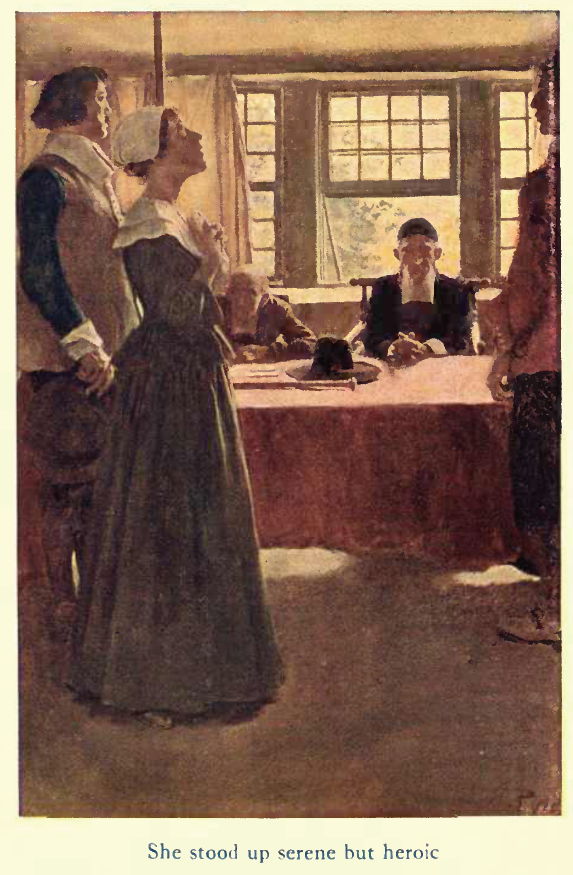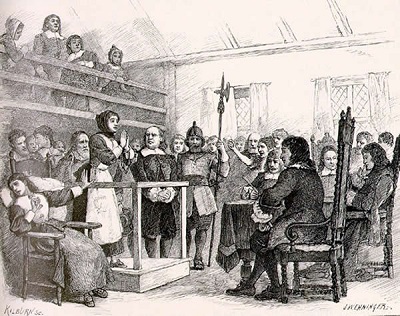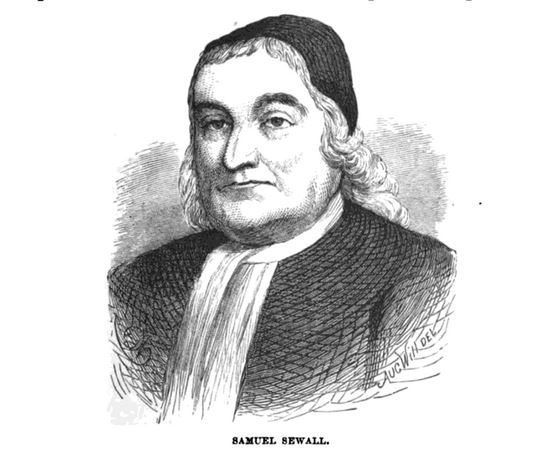The Salem Witch Trials judges were several men who served as judges during the Salem Witch Trials in 1692.
On May 27, 1692, Sir William Phips appointed nine of the colony’s magistrates to serve as judges on the newly created Court of Oyer and Terminer. The court was created specifically to handle the growing number of cases in the Salem Witch Trials.
According to a letter that Sir William Phips sent to the Earl of Nottingham in October of 1692, he chose these specific men for the job because they “were persons of the best prudence and figure that could then be pitched upon.”
These judges had a lot in common. They were wealthy merchants and high ranking militia officers. All nine had been judges for years and were all members of the Governor’s Council. Six of them were also related by marriage and five of them had attended Harvard, a training ground for young ministers, yet none of them became ministers.
According to Emerson W. Baker in his book, A Storm of Witchcraft, these nine judges were considered the elite of the Massachusetts Bay Colony:
“As a group, the judges represented the proverbial 1 percent – the merchant elite who were wealthy, intermarried, and exercised power in social, political, and military circles. In short, they were the superrich of Massachusetts. Simply calling them ‘merchants’ shortchanges them…Most had considerable political experience, having served as deputies and assistants in the General Court.”
Baker points out that they were also all middle aged, with Sewall the youngest at 40, while Richards, 67, and Stoughton, 60, were the oldest and the rest were between forty-five and fifty-three.
The judges served on the Court of Oyer and Terminer until it was dissolved in October of 1692. Then on November 25, 1692, the General Court passed legislation creating the Superior Court of Judicature and various lower courts.
Five of the nine Court of Oyer and Terminer judges were then appointed to the Superior Court of Judicature to hear the remaining witchcraft cases.
It’s not exactly clear why some of the judges were chosen for the Superior Court at the time while others were not, but some of the judges who were not chosen were later appointed to the court after the trials had ended.
The following is a list of names of the Salem Witch Trials judges:
Judges at the Examinations:
- Jonathan Corwin
- John Hathorne
- Bartholomew Gedney
- Thomas Danforth
Court of Oyer and Terminer Judges:
- William Stoughton, Chief Magistrate
- Jonathan Corwin
- Bartholomew Gedney
- John Hathorne
- John Richards
- Samuel Sewall
- Nathaniel Saltonstall
- Peter Sergeant
- Waitstill Winthrop
Superior Court of Judicature Judges:
- William Stoughton, Chief Magistrate
- Thomas Danforth
- John Richards
- Samuel Sewall
- Waitstill Winthrop
William Stoughton, Chief Magistrate:
William Stoughton was born in 1631 and graduated from Harvard in 1650. He continued his education at Oxford in England where he received a Masters in Art in 1653.
In 1662, Stoughton returned to the Massachusetts Bay Colony and lived in Dorchester, where he served as a clergyman.

From 1671 to 1674, Stoughton served as a selectman in Dorchester and then served as commissioner for the United Colonies from 1674 to 1676.
In 1676, Stoughton was sent to England with Peter Buckley, speaker of the House of Representatives, to prevent attempts by Robert Mason, proprietor of the neighboring Province of Maine, to have the Massachusetts Bay Colony’s charter revoked.
From 1680 to 1686, Stoughton served again as commissioner for the United Colonies.
In 1686, Stoughton was appointed to the Governor’s council, which assisted Andros in governing the newly created Dominion of New England.
In March of 1687, Stoughton was appointed Judge Assistant by Governor Joseph Dudley.
On May 14, 1692, Stoughton was appointed Lieutenant Governor of Massachusetts and later that month, on May 27, he was then appointed chief magistrate of the Court of Oyer and Terminer.
Stoughton is believed to be the person responsible for allowing the use of spectral evidence in the court during the Salem Witch Trials.
Stoughton served on the Court of Oyer and Terminer until it was dissolved in October of 1692.
On December 22, 1692, Stoughton was then appointed as the first Chief Justice of the Massachusetts Superior Court and heard the remaining witchcraft cases.
From 1694 to 1699 and again from 1700 to 1701, Stoughton served as acting governor of Massachusetts after Governor William Phips was recalled to England. He also continued to serve as chief justice of the Massachusetts courts until his death on July 7, 1701.
Jonathan Corwin:
Jonathan Corwin was born in Salem in 1640. He studied at Harvard but left after two years and became a merchant, like his father, before then becoming a deputy to the General Court in 1684.
Corwin was related to four of the other judges: Bartholomew Gedney, John Hathorne, Wait Still Winthrop, Peter Sergeant through the marriages of his siblings and his children.
In April of 1690, Governor Simon Bradstreet chose Corwin and Hathorne for a fact-finding mission to Maine to determine how to strengthen frontier defenses against Native-American attacks during King William’s War.
In 1692, Corwin was appointed as a judge to the Inferior Court of Common Pleas of Essex and was also appointed the commissioner of Excise and Impost and to the Governor’s council, which he served on until 1714.
When the Salem Witch Trials began in the spring of 1692, Corwin served as a judge at the examinations.
Then, on June 13, after Judge Nathaniel Saltonstall resigned from the Court of Oyer and Terminer, Corwin was appointed as his replacement. He served on the court until it was dissolved in October of 1692.
In 1715, Corwin was appointed to the Superior Court, a position he held until his death in 1718.
Bartholomew Gedney:
Bartholomew Gedney was born in Salem in 1640. He was a magistrate, physician, town selectman. merchant and the colonel of the Essex County militia.
In 1678, Gedney was elected as a deputy to the General Court and served on the court of assistants from 1680 to 1683. He was then appointed to Governor Andros’ council after the Dominion of New England was established in 1686.
In 1689, Gedney served on the Council for Safety in Boston along with John Hathorne.
In 1690, Gedney was offered command of an expedition against Port Royal in Acadia, during King William’s War, but he refused. The following year he was appointed to Governor Dudley’s council and then became the first judge of probate for Essex County in 1692.
Gedney’s daughter Lydia was married to Sheriff George Corwin, nephew of judge Jonathan Corwin.
In the early spring of 1692, Gedney was present at several of the Salem Witch Trials examinations and, in May of 1692, he was appointed to the Court of Oyer and Terminer, which he served on until it was dissolved in October of 1692.
Bartholomew Gedney died on February 28, 1697.
John Hathorne:
John Hathorne was born in Salem in 1641. Upon coming of age, Hathorne became a merchant before becoming a member of the colony’s council of assistants.
In 1689, Hathorne and Corwin served on the Council for Safety in Boston. In April of 1690, Hathorne and Corwin were sent on a fact-finding mission to Maine to determine how to strengthen defenses there against Native-American attacks.

When the Salem Witch Trials began in the spring of 1692, Hathorne became the chief examiner. He was then appointed to the Court of Oyer and Terminer, which he served on until it was dissolved in October of 1692.
In 1696, Hathorne served as the commander-in-chief in the failed Siege of Fort Nashwaak in Nova Scotia during the ongoing King William’s War.
In 1702, Hathorne was appointed to the Superior Court. He held this position for 10 years before he finally resigned in 1712 and then died in 1717.
John Richards
John Richards was born in Somerset, England in 1625 and migrated to the Massachusetts Bay Colony with his family in 1630.
Upon coming of age, he became a merchant and lived briefly in Maine, where he established a trading post, before returning to Massachusetts and settling in Dorchester, where he became a major in the Suffolk militia.
In 1654, Richards married Elizabeth Hawkins-Long-Winthrop, widow of Nathaniel Long and Adam Winthrop.
From 1679 to 1680, Richards served in the House of Deputies of the Massachusetts Bay Colony.
From 1680 to 1684, Richards served on the Court of Assistants, which was the colony’s highest court.
In 1680, Richards was appointed a trustee for the Society of Propagation of the Gospel in New England, which was a missionary society dedicated to converting Native-Americans to Christianity.
In 1681, Richards was sent to London, England to defend the colony’s charter and administration from ongoing efforts by neighboring colonies to have its charter revoked.
From May to December of 1686, Richards served as a judge in Governor Joseph Dudley’s administration, in the newly created Dominion of New England, until Governor Edmund Andros arrived in December and took over control control of the Dominion. After the Dominion was overthrown in 1689, Richards served again on the Court of Assistants.
In May of 1692, Richards was appointed to the Court of Oyer and Terminer where he served until it was dissolved in October of 1692.
Richard’s wife, Elizabeth, died in 1691 and the following year he married Ann Winthrop, sister of Wait Still Winthrop, on September 1, 1692. William Stoughton officiated the wedding ceremony and many of the Salem Witch Trials judges were in attendance.
In November of 1692, Richards was appointed to the Superior Court of Judicature to hear the remaining witchcraft cases. He remained on the court until his sudden death during a fit of apoplexy on April 2, 1694.
Nathaniel Saltonstall
Nathaniel Saltonstall was born in Ipswich, Massachusetts in 1639. He graduated from Harvard in 1659 and served as a Deputy to the General Court from 1666 to 1671.
From 1668 to 1700, Saltonstall was Town Recorder and Clerk of the Writs. He also served in the militia from 1679 to 1686 and became a major in the Haverhill militia.
From 1679 to 1686, Saltonstall served on the Court of Assistants, until the Dominion of New England was established. After the Dominion was overthrown in 1689, he resumed his position on the Court of Assistants until 1692.
In May of 1692, Saltonstall was appointed to the Court of Oyer and Terminer. He only held that position for a few weeks, suddenly resigned later that month after becoming “very much dissatisfied with the proceedings.” He was replaced by Corwin.
Saltonstall died on May 21, 1707 in Haverhill, Massachusetts.
Peter Sergeant
Peter Sergeant was born in London, England in 1647. He became a merchant in England before moving to the Massachusetts Bay Colony in 1667, where he settled in Boston. He served as town constable in 1674, and as a Councillor from 1692–1703 and 1707–1714.
Sergeant was married four times: first to Elizabeth Corwin, then to Elizabeth Shrimpton from 1682 to 1700, then to Mary Phips from 1701 to 1706 and then to Mehitable Cooper from 1706 to 1714.
In May of 1692, Sergeant was appointed to the Court of Oyer and Terminer, which he served on until it was dissolved in October of that year.
Peter Sergeant died in 1714.
Waitstill Winthrop
Waitstill Winthrop was born in Boston, Massachusetts in 1642. Winthrop was raised in Connecticut, where his father, John Winthrop the Younger, was governor of the Connecticut colony. Winthrop attended Harvard but left after two years.
Winthrop then served in the Connecticut militia for 10 years before moving to Boston in 1684, where he and his brother Fitz-John served on Governor Edmund Andros’ council in the Dominion of New England.
After the Dominion of New England was overthrown in 1689 and Simon Bradstreet was reinstated as governor, Winthrop was appointed commander in chief of the Massachusetts Bay Colony’s militia.
In May of 1692, Winthrop was appointed to the Court of Oyer and Terminer, which he served on until it was dissolved in October of 1692.
In November of 1692, Winthrop was appointed to the Superior Court of Judicature to hear the remaining Salem Witch Trials cases.
Winthrop remained on the Superior Court of Judicature until he resigned in 1701. In 1708, he was appointed chief justice, a position he held until his death in 1717.
Thomas Danforth
Thomas Danforth was born in England around 1623. His mother died in 1634 and his father moved the family to the Massachusetts Bay Colony shortly after. In 1638, Danforth’s father died and young Thomas was left to raise his siblings.
In 1644, Danforth married Mary Withington and they had 12 children together.
In 1645, Danforth was elected selectman and town clerk in Cambridge. He was then appointed treasurer of Harvard College in 1650 and served as steward of the college from 1669 to 1682.
In 1657, Danforth was chosen to represent Cambridge as a delegate in the General Court.
In 1659, Danforth was appointed to the court of assistants. In 1665, Danforth became a member of a commission overseeing the extension of Massachusetts colonial authority over the area that is now southern Maine.
In 1679, Danforth was elected deputy governor of the Massachusetts Bay Colony and was annually re-elected until the dissolution of the Massachusetts Bay Colony charter in 1686.
Also in 1679, Danforth was appointed by the General Court as President of the Province of Maine, which Massachusetts claimed to have jurisdiction over at the time (Washburn 247.)
When the Salem Witch Trials began in the spring of 1692, Danforth served as a judge at the examinations but was not appointed to the Court of Oyer and Terminer.
In November of 1692, Danforth was appointed to the Superior Court of Judicature to hear the remaining witch trial cases.
Thomas Danforth died on November 5, 1699.
Samuel Sewall
Samuel Sewall was born in Bishopstoke, England in 1652. His family had previously lived in the settlement of Newbury in the Massachusetts Bay Colony before returning to England, where Sewall was born. The Sewall family returned to Massachusetts in 1661.

In 1671, Sewall graduated from Harvard and then received his master of arts in 1674.
In 1676, Sewall married Hannah Hull and joined her father in his silversmith and minting businesses and then became a constable in 1679.
In 1681, Sewall was appointed to the Massachusetts General Court and was also appointed by the General Council to run the colony’s printing press.
When Sewall’s father-in-law died in 1683, he inherited his businesses.
In 1684, Sewall was elected to the Court of Assistants and soon after became a Suffolk county judge and a captain in the Boston militia.
When the Dominion of New England was established in 1686, Sewall declined to serve on the council and instead traveled to England with Increase Mather to assist in his efforts to restore the Massachusetts Bay charter of 1629.
Sewall returned from England in 1690, and was formally named to the Governor’s Council.
In May of 1692, Sewall was appointed to the Court of Oyer and Terminer, which he served on until it was dissolved in October of that year.
In November of 1692, Sewall was appointed to the Superior Court of Judicature and was later appointed Chief Justice of that court in 1717.
In January of 1697, Sewall issued a public apology for his role in the Salem Witch Trials. He was the only Salem Witch Trials judge to do so.
Samuel Sewall died on January 1, 1730 in Boston, Massachusetts.
Sources:
“About the Supreme Judicial Court.” Mass.gov, www.mass.gov/service-details/about-the-supreme-judicial-court
“Samuel Sewall Takes the Blame and Shame for the Salem Witchcraft Trials.” New England Historical Society, www.newenglandhistoricalsociety.com/samuel-sewall-takes-blame-shame-salem-witchcraft-trial/
“William Stoughton.” Stoughton History, Stoughton Historical Society, www.stoughtonhistory.com/williamstoughton.htm
Moody, Robert E. “Records of the Magistrates’ Court at Haverhill, Massachusetts, Kept by Nathaniel Saltonstall, 1682-1685.” Proceedings of the Massachusetts Historical Society, vol. 79, 1967, pp. 151–186. JSTOR, www.jstor.org/stable/25080641.
Sibley, John Langdon. Biographical Sketches of Graduates of Harvard University in Cambridge, Massachusetts.Vol. II,1659-1677, Charles William Server, 1881.
Baker, Emerson W. A Storm of Witchcraft: The Salem Witch Trials and the American Experience. Oxford University Press, 2015.
Foulds, Diane. Death in Salem: The Private Lives Behind the 1692 Witch Hunt. Globe Pequot Press, 2010.
“Old Burying Ground, Dorchester.” Salem Witch Museum, salemwitchmuseum.com/locations/old-burying-ground-dorchester/
“The Deadly Rules of Massachusetts’ Court of Oyer and Terminer.” New England Historical Society, www.newenglandhistoricalsociety.com/rules-massachusetts-court-of-oyer-and-terminer/
Baker, Emerson W. “The Salem Witch Trial Judges: ‘Persons of the Best Prudence’?” OUPBlog, Oxford University Press, blog.oup.com/2015/05/salem-witch-trial-judges/
